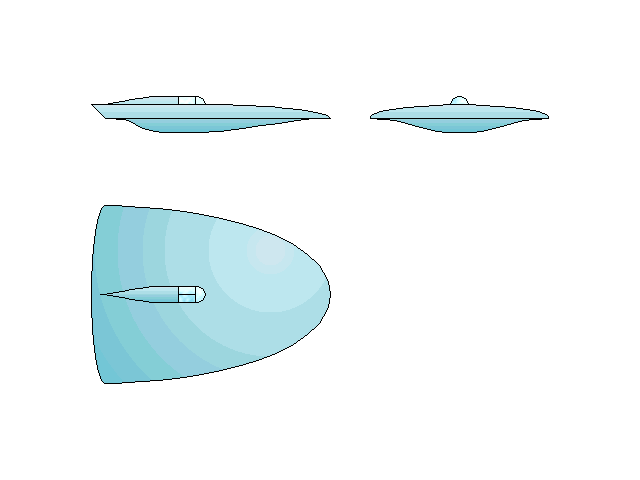
General Purpose transorbital and interplanetary aerodynamic Shuttle (Type III)
Designer: Robert C. Dunehew E-mail [email protected]

General Purpose transorbital and interplanetary aerodynamic Shuttle (Type III)
General Specifications:
Length: 24m
Width: 17.9m
Height: 3.7m
Max. Impulse: 0.1 lightspeed, later upgraded to .25 lightspeed.
Crew: 1 pilot.
Passengers: Normally not more than 42. Emergency occupancy of up to 92.
Armaments: None.
Type: General purpose trans-orbital and interplanetary aerodynamic shuttle.
Status: 183 produced. Production began in 2177 and ran for 60 years.
About Ship: The type III General Purpose transorbital and interplanetary aerodynamic Shuttle (GPS-III, Nicknamed "Jeeps-3") was designed to provide Starfleet with a larger utility shuttle than previous ship-transportable designs.
Prior to the advent of transporter technology, aerodynamic shuttles were the only means to transport away teams and equipment toand from a planetary surface. Previous shuttles were necessarily small due to the limited size of earlier shuttlebays, and required many trips between orbit and surface to transfer personnel and equipment to a planetary surface. The Jeeps-3 could perform this task in a single trip. The Jeeps-3 was designed to perform not only that role, but was also intended to perform several other missions besides.
The interior layout of the Jeeps-3 was spartan but almost infinitely configurable. The main deck was half an ellipse in cross-section, with a maximum deck-to-overhead height of 1.55m and a maximum width of 1.6m. A slightly larger secondary deck below the primary deck offered additional cargo and passeger space, and included a loading ramp to the rear. The lower deck also included minimal crew bunks for the pilot and copilot, as well as sanitary facilities.
Emergency stores (such as emergency food, water, and medical supplies) were packed into compartments within the "wings" of the lifting body, accessible from within the vessel. Most of the life support, avionics, controls and propulsion system were accommodated within the wing-like portion of the Jeeps-3's structure as well. The floor deck plates of the upper deck (over the lower compartment) could be removed to accommodate outsized cargo when necessary.
The Jeeps-3 was equipped with pre-installed sling seats that folded out of the bulkheads to allow the vessel to function as an emergency escape vessel, in case of catastrophic damage to the main ship. These sling seats boosted carrying capacity, allowing up to 90 passengers to be carried in an emergency. In ordinary use, however, the Jeep-3 rarely saw use as a life boat, and had permanent seating for only two crew members, a pilot and a copilot, located in the cockpit.
Behind the cockpit, the Jeep-3's utility deck could be configured to carry cargo, a mobile research station, or passenger seating. Specialized pallets were available which bolted to the decks to configure the vessel for each mission. As a cargo vessel, it carried cargo pallets and containerized cargo. As a mobile research station, it carried living quarters, sensors, and a small research facility for the research crew. As a passenger vessel, passenger seat pallets with two rows of four seats abreast, with a central aisle between pairs of seats were available. Up to five of these passenger pallets could be installed.
Propulsion and electrical power was provided by a distributed network of microfusion thruster packs distributed along the aft surface of the "wing". Aerodynamic control was provided by slots and spoilers located along the leading and trailing edges of the lifting body, as well as along its upper and lower surfaces. Nonaerodynamic control was provided by standard reaction control thrusters. The Jeeps-3, while not particularly agile, was quite maneuverable.
The Jeeps-3 was provided with VTOL capability by the inclusion of microfusion thruster packs distributed along the lower surface of the lifting body. During atmospheric operations, the effectiveness of these thrusters could be augmented by entrained atmospheric gases ducted through from the upper surface of the lifting body. This not only increased lift, but cooled and dispersed the hot exhaust of the thrusters, reducing the potential for damaging the landing surface.
The Jeeps-3 remained in production until well after transporters and non-aerodynamic shuttlecraft had been introduced. Due to its versatility and excellent safety record, The Jeep-3s were refit with uprated thrusters and avionics, and continued to serve aboard starbases and as general purpose transorbital and interplanetary shuttles (though no longer aboard starships) until the late 2250s. Several examples of this type are preserved in museums throughout the Federation.
Return to the Starship Catalogue.